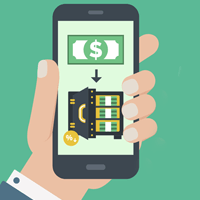Mobile Payments for Physical Goods

 According to a recent report from ABI Research, mobile payments in the U.S. could reach $2.4 billion in 2010, growing by 100 percent in one year. The problem is that mobile payments still represent just eight percent of the total projected ecommerce market. Compare that to the Japanese market, where physical goods billing is a commodity, and mobile payments make up almost 20 percent of ecommerce. Adding physical goods billing in the U.S. would easily double ABI's predictions.
According to a recent report from ABI Research, mobile payments in the U.S. could reach $2.4 billion in 2010, growing by 100 percent in one year. The problem is that mobile payments still represent just eight percent of the total projected ecommerce market. Compare that to the Japanese market, where physical goods billing is a commodity, and mobile payments make up almost 20 percent of ecommerce. Adding physical goods billing in the U.S. would easily double ABI's predictions.
As you might guesss it is a competitive market and one that requires further monitoring and exploration.
Mobile payment solution provider mopay today anounced that it supports the the purchase of physical goods through their platform in 28 countries. mopay's product line is pretty deep including mopay web (ideal for digital goods and a competitor of PayPal), mopay wap (a mobile payment system that puts charges on a phone bill), and mopay sms among others.
The scope of mobile payments varies significantly between global markets. As of today, mobile payments in the western hemisphere are primarily used to purchase digital and virtual goods - such as music and in-game items - via a mobile phone account. In selected Asian and European countries, mobile phone users are able to purchase virtually everything from tickets to movie downloads to physical goods through their phone bill.
"mopay's ultimate goal is to not only be a major payment option for digital and virtual goods, but for all kinds of purchases," said Kolja Reiss, managing director of mopay, Inc. "The Asian market is once again leading the way in purchasing physical goods via mobile phones and other markets are hot on their heels. By constantly adjusting our offering to keep pace with new developments, mopay actively pushes mobile payments to essentially become a replacement for cash and other intricate methods of payment, foreseeably eliminating the need for the traditional 'wallet' as we know it."

Subscribe to Our Newsletter!
Latest in Mobile Marketing










